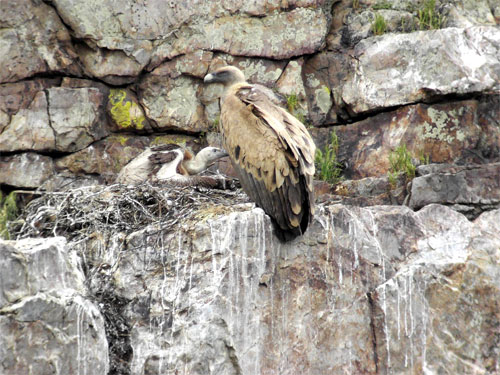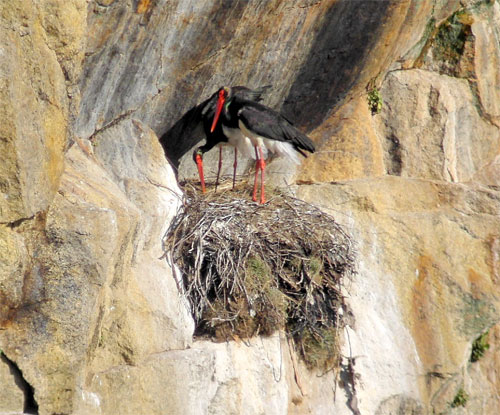
Southern Grey Shrikes, Embalse de Talavan, site CC5.
Living in central France, it’s 12 hours drive to Caceres, so we decided to spend ten days birding Caceres province. We stuck to the plan, never venturing further south to the better known La Sarena plains or other Badajoz hotspots.
The aim was to get good views of both sandgrouse species on the deck, and hopefully still displaying bustards.
We used a single source of reference, WTWB SOUTHERN AND WESTERN SPAIN, Garcia/Paterson, Helm 2001.
SITES VISITED.
The sites are referenced as in the above guide, ‘CACERES PROVINCE’, page 287.
CC1 The plains of western Caceres.
CC3 Caceres-Trujillo steppes.
CC5 Cuatro Lugares steppes.
CC6 Monfrague.
CC9 Campo de Aranuelo.

Trujillo
ACCOMMODATION.
We used campsites at Alcantara, Caceres, and Camping Monfrague, outside the park.
Alcantara site is through the town and on the road to Portugal [route EX-207], high up overlooking the Embalse de Alcantara, and is sign-posted. It’s fairly small and uncommercialized, I believe there’s a larger one somewhere nearby.
Caceres Camping is near the football stadium on the NW side of town, route N-630;
Camping ‘Cuidad de Caceres’
National route N630, km 549.5
10005 Caceres
Tel. 927 233 100
Email info@campingcaceres.com
Monfrague camping is on north side of park towards Plasencia on the Ex-208 km 10;
Camping Parque Natural de Monfrague
10680 Malpartida de Plasencia
Tel. 927 45 92 33/20
Note: There is now no camping within the park, as stated in the book.

Eagle Owl, Monfrague
SITES.
CC1 Western Plains.
The campsite itself is good, in particular a small quarry/picnic area 5 minutes walk from the site. We saw some key Monfrague species there – see species list.
The plains, although initially disappointing, did give us our first bustard sightings, 4 Great and 2 Little, by taking a farm track north of the EX-302, although two were visible from the road. The flower-rich meadows with plenty of Calandras and Quail are best looked at. First Rollers near nestboxes on the EX-207 at ‘D’ on map. Embalse de Mata de Alcantara not bad for waterbirds.
CC 3 Caceres-Trujillo Steppes.
Our biggest concentration of Great Bustards, 53 and many still displaying, at point ‘A’ on map in book, from the green gates overlooking the stony hillside near a large finca, also our only displaying Littles. Good waders at Embalse de Guadiloba. Our only sandgrouse, 5 Black-bellied and 27 Pin-tailed, feeding all morning on a stony meadow at ‘G’ in the book. Sightings of both bustards at various places, but no other large gatherings.
CC6 Monfrague
Nesting Eagle Owl pair and Spanish Imperial pair.
NB I will not give away rare bird nesting sites on the internet. Best to ask locally on arrival, there are some very helpful Spanish birders around, and Dutch who often stay for longer periods than most of us. Hopefully the photographer who disappeared into the scrub at the eagle site had no effect on their success.
The other stuff is all fairly easy to find, see species list.
CC5 and CC9.
We did some of CC5, good for arid species, and Embalse de Talavan is good photographically.
CC9 is good for waterbirds and odonata at Embalse de Arrocampo-Almaraz.

Griffons, Monfrague
REFERENCES.
Whatever mapping one decides to use, I would advise using something bang up to date. The Spanish must have used up all the EEC road-building budget themselves…..also they like changing road numbers. Serves us right for using something 10 years old, I guess.
I would thoroughly recommend the Earnest Garcia and Andrew Paterson book, although I’m sure they’d admit it needs a little updating; but at what stage do you go to the expense of a re-print?

Black Storks, Alcantara
1. BLACK-NECKED GREBE 2 Embalse de Mata de Alcantara 17/4.
2. LITTLE GREBE 1 Embalse de Mata de Alcantara 17/4, 2 Embalse de Talavan 18/4.
3. GREAT CRESTED GREBE 15+ Embalse de Mata de Alcantara 17/4, seen on most reservoirs.
4. CORMORANT Small numbers on larger reservoirs.
5. LITTLE BITTERN 1 female Embalse de Arrocampo 24/4.
6. CATTLE EGRET Singles seen occasionally, c200 in flight east of Trujillo 21/4.
7. LITTLE EGRET Small numbers on larger reservoirs.
8. GREY HERON Singles even on smallest reservoirs.
9. PURPLE HERON 1 Embalse de Arrocampo 24/4.
10. WHITE STORK Very common breeder throughout.
11. BLACK STORK 1 pair Alcantara, 2 pairs Monfrague, singles often seen in flight.
12. MALLARD Common breeder, all reservoirs.
13. GADWALL 2-3 pairs on most larger reservoirs.
14. GRIFFON VULTURE Common breeder in all suitable areas.
15. BLACK VULTURE Often seen well away from Monfrague, at Alcantara campsite and Caceres, 5 on still-born lamb with c25 Griffons near Santa Marta 20/4. Fairly common Monfrague.
16. EGYPTIAN VULTURE 1 adult around campsite, Alcantera, 1 pair castillo, Monfrague. Singles often seen Monfrague, all adults.
17. SPANISH IMPERIAL EAGLE 1 pair nesting near Monfrague, seen 23/4 and 24/4. A single seen in flight Mirador Portilla del Tietar, Monfrague 23/4.
18. SHORT-TOED EAGLE 1-3 seen most days throughout. 5 together Embalse de Arrocampo 24/4.
19. BOOTED EAGLE A pair sometimes displayed over campsite, Alcantara. 2-3 sightings per day throughout. 1 dark morph Caceres campsite 19/4, all others pale morph.
20. BONELLI’S EAGLE 1 adult Alcantara campsite 16/4. 1 adult, 1 imm. castillo, Monfrague, 23/4.
21. RED KITE 1 Alcantara campsite 18/7, 1 over Trujillo 21/4.
22. BLACK KITE Probably the commonest bird.
23. MONTAGU’S HARRIER Seen from 19/4 on plains areas around Caceres and Trujillo, fairly common by 22/4.
24. COMMON BUZZARD 2 Caceres plains 17/4, also 1 18/4, 2 19/4 and 1 20/4. Probably can’t compete with the huge numbers of breeding Black Kites.
25. KESTREL 2-3 seen most days, usual care needed between towns on the plains with breeding Lesser Kestrels. 1 male castillo, Monfrague 23/4.
26. LESSER KESTREL Common breeder with some nice colonies, eg Brozas and Trujillo.
27. RED-FOOTED FALCON 1 adult male on fencepost beside the main N620/E80 road near Salamanca 15/4. Most unexpected, a very rare passage bird here, although there are records of a female at Salamanca 29/3/03 and a male at Cacares 9/4/04.
28. RED-LEGGED PARTRIDGE Fairly common Caceres-Trujillo plains that are more hilly and rocky.
29. QUAIL Common in the richest of the plains fields; the ones with Calandra Larks and bustards in.
30. MOORHEN 3 Embalse de Talavan 18/4, 1-2 pairs on most large reservoirs.
31. COOT 20+ Embalse de Mata de Alcantara.
32. GREAT BUSTARD 4 from farm track north of C522 at km40 17/4, total 57 farm track north of Torreorgaz 19/4, 22 farm tracks around Embalse de Guadiloba 20/4, 13 road south of Santa Marta de Magasca 21/4.
33. LITTLE BUSTARD 2 males farm track north of C522 at km40 17/4, 3 [2 males] farm tracks around Embalse de Guadiloba 20/4.
34. BLACK-WINGED STILT 1-2 pairs seen on most medium to large reservoirs, sometimes smaller ones.
35. STONE CURLEW 1 farm track north of C522 at km40 17/4, 1 pair on road south of Santa Marta de Magasca 21/4.
36. COLLARED PRATINCOLE 1 adult summer-plumaged bird Embalse de Guadiloba 20/4; a long way from the coast.
37. LITTLE RINGED PLOVER c10 pairs Embalse de Guadiloba 20/4.
38. RINGED PLOVER 2 adult summer birds Embalse de Guadiloba 20/4.
39. LAPWING 2 Embalse de Guadiloba 20/4.
40. TEMMINCK’S STINT 2 Embalse de Guadiloba 20/4.
41. LITTLE STINT 7 Embalse de Guadiloba 20/4.
42. WOOD SANDPIPER 1 Embalse del Salor 19/4.
43. COMMON SANDPIPER Most common wader, on all medium to large reservoirs. 10+ Embalse de Guadiloba 20/4.
44. SPOTTED REDSHANK 11 Embalse de Mata de Alcantara 17/4.
45. GREENSHANK Seen on most reservoirs. 6+ Embalse de Guadiloba 20/4.
46. BLACK-HEADED GULL 5 near Caceres 21/4.
47. YELLOW-LEGGED GULL First-winters; 1 Embalse de Salor 19/4, 1 Embalse de Guadiloba 20/4.
48. BLACK-BELLIED SANDGROUSE 5 [3 males] near Santa Marta de Magasca, with 27 Pin-tailed, 21/4.
49. PIN-TAILED SANDGROUSE 27 near Santa Marta de Magasca 21/4.
50. ROCK DOVE/FERAL PIGEON No definitely ‘pure’ birds seen. On the steppes some farmers keep domestic pigeons, sometimes seen flying in tight flocks.
51. COLLARED DOVE A few pairs seen in most villages.
52. CUCKOO Fairly common.
53. TAWNY OWL 1 Caceres campsite.
54. EAGLE OWL 1 adult and 1 nearly fledged young at nest site, Monfrague, 23/4 and 24/4.
55. LITTLE OWL Up to four a day seen on the steppes.
56. SCOPS OWL 1 Monfrague campsite.
57. SWIFT Common.
58. ALPINE SWIFT c35 at the castillo, Monfrague, 23/4.
59. HOOPOE Common throughout.
60. KINGFISHER 1 Embalse de Arrocampo 24/4.
61. BEE-EATER 2 Alcantara 16/4. Big arrival on 17/4 with flocks of 50+ going over, common thereafter.

62. ROLLER First bird arrived at nestboxes near Alcantara on 17/4, with the Bee-eaters. 4+ seen thereafter, and 1 near Santa Marta nestbox site, 20/4.
63. GREAT SPOTTED WOODPECKER 1 Monfrague 23/4.
64. LESSER SPOTTED WOODPECKER 1 Caceres campsite, very confiding.
65. SKYLARK A few pairs on Caceres meadows on territory.
66. CRESTED LARK Very common everywhere.
67. WOODLARK 1+ near Torrejon el Rubio 23/4 and 24/4.
68. SHORT-TOED LARK Several pairs seen on the cultivated plains.
69. CALANDRA LARK A common bird of the flower-rich steppe meadows.
70. CRAG MARTIN Seen all upland rocky areas and some reservoir dams.
71. SWALLOW Common throughout.
72. RED-RUMPED SWALLOW Fairly common throughout at obvious nesting sites, especially Monfrague.
73. HOUSE MARTIN Very common locally at bridge and dam nesting sites.
74. WHITE WAGTAIL Common.
75. ROBIN Very scarce in this dry habitat; three sightings.
76. NIGHTINGALE Common.
77. BLACK REDSTART 1 male, 1 female castillo, Monfrague, 24/4.
78. WHEATEAR Often seen on cultivated steppe and Alcantara campsite area.
79. BLACK-EARED WHEATEAR 2 males Caceres plains 17/4, 1 male near Santa Marta 21/4.
80. BLACK WHEATEAR Only seen near Alcantara campsite, where 2 pairs nesting.
81. WHINCHAT Only seen Caceres-Trujillo plains, three sightings.
82. STONECHAT Common throughout.
83. BLUE ROCK THRUSH 2 pairs near Alcantara campsite, c2 pairs castillo, Monfrague.
84. BLACKBIRD Common.
85. BLACKCAP Only noted in Monfrague.
86. SARDINIAN WARBLER Common throughout.
87. SUBALPINE WARBLER Numerous sightings Monfrague.
88. ZITTING CISTICOLA Common throughout.
90. CETTI’S WARBLER Common throughout.
91. REED WARBLER 1 Embalse de Arrocampo 24/4.
92. GREAT REED WARBLER 1 Embalse de Arrocampo 24/4.
93. WILLOW WARBLER 1 Alcantara 16/4, 2 Embalse de Arrocampo 24/4.
94. GREAT TIT
95. BLUE TIT
96. LONG-TAILED TIT Only seen Monfrague, 1-2 small flocks near the castillo.
97. SHORT-TOED TREECREEPER 1 Caceres campsite 19/4.
98. WOODCHAT SHRIKE Common throughout.
99. SOUTHERN GREY SHRIKE 1-2 pairs around most reservoirs.
100. AZURE-WINGED MAGPIE Very common, eg at all three campsites, where they would come to bread.
101. MAGPIE
102. JAY
103. JACKDAW
104. CHOUGH 2 pairs castillo, Monfrague 23/4.
105. CARRION CROW
106. RAVEN A few pairs seen both upland and steppe areas.
107. SPOTLESS STARLING Very common throughout.
108. GOLDEN ORIOLE The first arrivals started to sing from 24/4.
109. HOUSE SPARROW
110. SPANISH SPARROW Some large flocks 100+ on the steppes, and breeding near Alcantara campsite.
111. ROCK SPARROW 3+ in cork oak woodland near Monfrague, 24/4.
112. CHAFFINCH
113. LINNET
114. GOLDFINCH
115. GREENFINCH
116. SERIN
117. HAWFINCH 3 Alcantara campsite, evening, 16/4.
118. CORN BUNTING
119. ROCK BUNTING 2 males foot of castillo, Monfrague, 24/4.
Odonata at the Embalse de Arrocampo-Almaraz;
Scarlet Darter
Long Skimmer
Banded Groundling

Banded Groundling